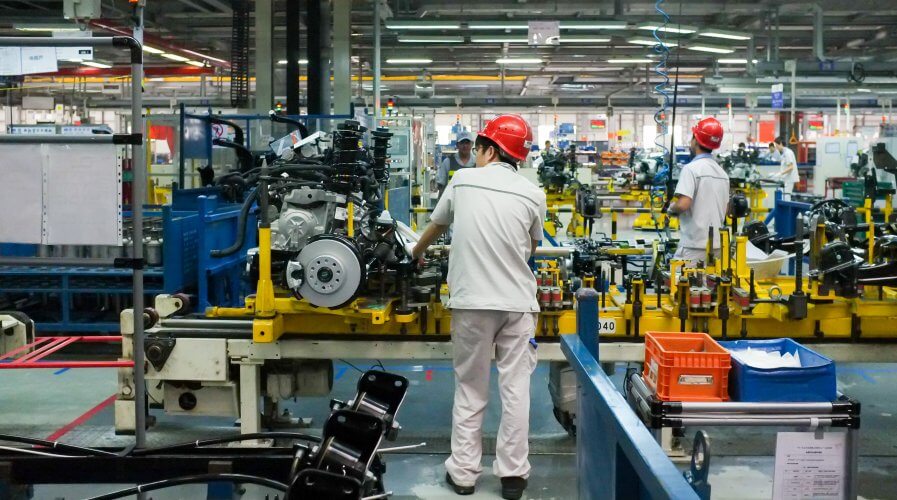
China set to maintain its competitive advantage in the manufacturing sector in the APAC region, thanks to its early adoption of IIoT technology. Source: Shutterstock
How China is accelerating industrial growth using IoT
WHEN regulators understand technology, they’re able to not only clear the path for its adoption in the country but also remove obstacles in terms of investments and skills/know-how when it comes to supporting the last-rung of businesses in the country.
That’s exactly the case with China and its race to help local businesses jump onto the IoT bandwagon.
IoT technology is essentially a set of hardware and software that are integrated into a network to gather and transmit data, to drive automation and big data analytics within industries.
IoT improves upon its predecessor – machine-to-machine (M2M) technology – by incorporating more sophisticated mobile networks technologies and artificial intelligence (AI).
It is widely considered as the key to transitioning to Industry 4.0 which calls for digitalization of industrial processes and deployment of smart manufacturing strategies.
And naturally, China, having already established itself as the workshop of the world, perceives these efforts as a critical endeavor that will help the country weather the shifts in the economy that might threaten its global position.
A global leader in IIoT adoption
According to a recent report by law firm Osborne Clarke produced in association with digital publishers Conventus Law, China already leads the APAC region in terms of Industrial IoT (IIoT) application.
The mass adoption was brought about due to the increased competition within the manufacturing sector, resulting in companies resorting to emerging technologies to gain operational efficiency.
One such example of the deployment is telco manufacturer, Ericsson, which has implemented IIoT at its Nanjing plant.
By partnering with local telco provider, China Mobile, the Swedish outfit transformed its operation into a smart manufacturing plant, connecting over 1,000 high-precision screwdrivers using narrowband IoT (NB-IoT) and 4G LTE category M1 to communicate with motion sensors and data analyzed in the cloud.
“Once those screwdrivers were connected, we could then monitor how they were being used, the force being applied, etc. Not just for maintenance purposes, but also to monitor how efficient they are, as well as for training and replacement purposes,” said Ericsson’s Global Head of IoT Customer Engagements Warren Chaisatien.
According to him, the deployment of the technology has led to a significant reduction of workload (50 percent) and costs (10-12 percent). Further, the project broke even within six months and delivered a 210 percent return on investment.
Use cases beyond manufacturing
Meanwhile, China’s growth in the manufacturing sector had also led to a rise in the e-commerce industry.
Being digital natives and inherently forward-looking, the county’s e-commerce players were quick to adopt IIoT to take advantage of the efficiency the technology offered.
Alibaba and JD.com, China’s two leading e-commerce giants, are exceptionally quick to deploy new, innovative technologies that save time or cost, the Osborne Clarke report noted.
For instance, Alibaba launched a smart warehouse in Huiyang in 2017 leveraging IIoT technology to power 60 automated guided vehicles (AGVs) that handled 70 percent of the facility’s workload.
According to the company, augmenting this technology with its human workforce had allowed one employee to sift through 3000 products during a single shift, a 100 percent improvement from 1500 products before the deployment.
The success propelled the company to open another smart facility in Wuxi the following year, only this time with close to 700 AGVs to support its 11.11 sale.
In a nutshell, China’s early adoption of IoT technology has led to early success in its transformation agenda and has presented businesses with an opportunity to invest in better connectivity to capitalize on the efficiency, speed, and savings the technology has to offer.
China’s future will have many more successes with IoT for sure — thanks to the support offered by the government, smart vendors in the market, and the incredibly viable use cases being developed by pioneers in the country.
READ MORE
- Safer Automation: How Sophic and Firmus Succeeded in Malaysia with MDEC’s Support
- Privilege granted, not gained: Intelligent authorization for enhanced infrastructure productivity
- Low-Code produces the Proof-of-Possibilities
- New Wearables Enable Staff to Work Faster and Safer
- Experts weigh in on Oracle’s departure from adland






